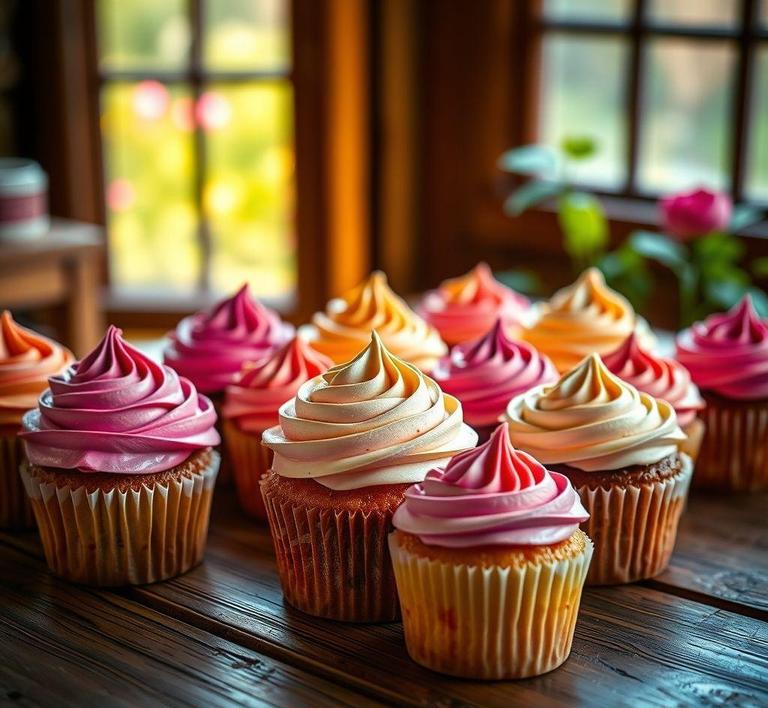Refreezing cupcakes may sound like an odd idea, but it’s actually a handy technique when you want to save some treats for later without sacrificing their taste or texture. Whether you baked a batch and couldn’t finish them all, or just want to keep some on hand for a future party, refreezing cupcakes can help you preserve their freshness. The key to doing it right is knowing how to properly store them so they don’t lose their moisture or become stale. In this guide, we’ll walk you through the best methods for refreezing cupcakes, including how to wrap them, how long they can be stored, and tips to ensure they stay just as delicious as the day you made them!
Can You Refreeze Cupcakes?

Cupcakes are one of the most beloved desserts worldwide-small, sweet, and wonderfully customizable. Whether it’s a special occasion or just a treat for yourself, cupcakes can be a real indulgence. However, the question often arises: Can you refreeze cupcakes? The answer, in short, is yes, but with some important nuances to consider.
Refreezing cupcakes isn’t as simple as tossing them back into the freezer after they’ve thawed. In fact, cupcakes, like many other baked goods, can lose their texture and flavor when frozen and thawed multiple times. But if you’re in a situation where you have leftover cupcakes or need to store them for a longer period, it’s still possible to refreeze them without completely sacrificing quality-though a few key steps need to be followed to minimize any negative impact.
How To Refreeze Cupcakes?
The process of refreezing cupcakes requires some care to ensure that they remain as fresh as possible, even after being frozen, thawed, and refrozen. Here’s a step-by-step guide to help you do it right:
-
Cool the Cupcakes Completely:
Before freezing or refreezing any cupcakes, make sure they are completely cooled. If you freeze them while still warm, condensation can form inside the wrapping, which will lead to sogginess and changes in texture upon thawing.
-
Wrap Them Properly:
Proper packaging is key to protecting your cupcakes during the refreezing process. To do this, you should wrap each cupcake individually in plastic wrap or aluminum foil to prevent freezer burn. If the cupcakes are decorated with frosting or delicate toppings, be extra cautious when wrapping to avoid crushing them. Once wrapped, place them inside a zip-top freezer bag or airtight container for added protection.
-
Store Them in a Single Layer:
If you’re placing multiple cupcakes in the same container, make sure they are stored in a single layer. If you have to stack them, place a piece of parchment paper or wax paper between layers to prevent the cupcakes from sticking together.
-
Label and Date:
Always label your cupcakes with the date they were frozen. While cupcakes can be stored in the freezer for several weeks, it’s a good idea to use them within 1-2 months to ensure the best quality.
-
Thaw and Refreeze:
When you’re ready to refreeze the cupcakes, the process should be just like the initial freezing process. Let them thaw slowly at room temperature or in the fridge. Avoid microwaving or using heat to thaw them, as this can cause uneven defrosting and damage to the texture.
-
Refreeze in Small Batches:
If you’ve already thawed a few cupcakes and eaten some of them, it’s not ideal to refreeze the remaining ones. Refreezing partial amounts can lead to uneven texture and flavor deterioration. So, try to only refreeze cupcakes that have remained untouched.
Quality Impact
While it’s possible to refreeze cupcakes, it’s important to understand that doing so can impact their quality. Here are some of the key factors to consider when refreezing:
-
Texture Loss:
One of the biggest drawbacks of refreezing cupcakes is the potential loss of texture. Cupcakes are naturally light and fluffy, but freezing can cause ice crystals to form within the batter. When the cupcakes thaw, they can lose that airy, moist texture, becoming a bit more dense or dry than when they were originally baked. Refreezing them will likely amplify this issue, making the texture even less desirable.
-
Frosting and Topping Issues:
The quality of frosting or any delicate toppings like sprinkles, fruit, or candy can also suffer when refrozen. Frosting made with butter or cream cheese, for example, can separate or become grainy after freezing and refreezing. While the cake part of the cupcake might retain some moisture, the frosting might crack or lose its smooth finish.
-
Flavor Alteration:
Freezing and refreezing cupcakes can dull their flavors. The process of freezing can sometimes mute the sweetness or any subtle flavor notes, particularly if the cupcakes contain fresh ingredients like fruit, cream, or custard. The flavors may not be as vibrant after they’ve been thawed and refrozen, leading to a less enjoyable experience overall.
-
Moisture Loss:
The process of freezing and thawing causes moisture to migrate out of baked goods, and when you refreeze them, you risk further drying out the cupcakes. If the cupcakes weren’t wrapped properly or stored in an airtight container, they could lose even more moisture, resulting in a dry and crumbly product.
-
Overall Aesthetic Appeal:
Refrozen cupcakes may not look as appealing as freshly made ones. With the potential for frosting changes, slight shrinkage of the cupcake, or frosting smudges, the visual appeal of the cupcakes can diminish after they’ve been frozen and refrozen.
Refreezing cupcakes is possible, but it’s not without its challenges. The act of freezing and thawing any baked goods multiple times can degrade their texture, flavor, and visual appeal. However, if done with care-such as ensuring the cupcakes are properly wrapped, stored, and thawed-refreezing can still work in a pinch, especially if you’re not overly concerned about perfection.
If you plan to refreeze cupcakes, remember to do so as soon as possible after they’re thawed, and try to only refreeze those that have not been consumed. It’s best to accept that refrozen cupcakes may not be quite as fresh as when they were first baked, but they should still be safe to eat and enjoyable-just perhaps not at their peak quality.
Is It Safe To Refreeze Cupcakes?
Cupcakes are a beloved treat-moist, fluffy, and often topped with layers of buttercream, fondant, or other sugary delights. But when life gets busy, you might find yourself with leftover cupcakes. The question arises: is it safe to refreeze cupcakes? The short answer is yes, it is possible, but it comes with a caveat.
The safety of refreezing cupcakes depends on how well they were initially frozen, how long they’ve been thawed, and how they’ve been stored. In principle, freezing and then refreezing cupcakes is not dangerous in itself, but it can lead to changes in their texture and flavor. Cupcakes are generally made from perishable ingredients like eggs, butter, and milk, which can be prone to bacteria growth if left out at unsafe temperatures for too long. Thus, if cupcakes are thawed at room temperature for more than two hours, they should not be refrozen due to the risk of bacterial contamination.
Furthermore, cupcakes with frosting can be particularly tricky. Buttercream and other frosting types can begin to melt and lose their smooth texture when thawed, making refreezing a bit of a gamble in terms of appearance and texture. While the refrozen cupcakes may still be safe to eat, they may no longer look or taste the same as when they were first made.
Signs That Cupcakes Should Not Be Refrozen
While cupcakes can be refrozen under certain conditions, it’s essential to look for signs that indicate it’s no longer safe or worthwhile to attempt refreezing. Here are a few things to watch for:
- Discoloration or Odor: One of the most noticeable signs that cupcakes should not be refrozen is a change in color or a sour, off-putting odor. If the cupcakes have been stored improperly and have begun to spoil, they may develop mold or an unpleasant smell, making them unsafe to eat.
- Soggy or Wet Texture: If the cupcakes were previously thawed and have become soggy, this is an indication that moisture has begun to seep into the cake. Excessive moisture can ruin the structural integrity of the cupcakes, making them unappetizing and potentially unsafe to eat. If they’re already mushy or wet, they won’t improve by refreezing.
- Frosting Separation: Cupcakes with frosting can suffer from separation if they’ve been thawed improperly. Frostings made with butter or cream may separate when they begin to thaw, leading to an uneven, unattractive appearance. If the frosting has lost its smooth texture or separated into oily puddles, it’s a sign that refreezing will make the cupcakes look worse rather than better.
- Long Thawing Time: If the cupcakes were left out at room temperature for an extended period (more than two hours), there’s a risk that they’ve entered the “danger zone” for bacterial growth. Refreezing them after this time could pose a health risk, as bacteria multiply rapidly in warm environments.
Common Refreezing Mistakes
When it comes to freezing and refreezing cupcakes, a few common mistakes can lead to undesirable outcomes. Here are some of the pitfalls to avoid:
- Not Allowing Cupcakes to Cool Completely: One of the biggest mistakes is freezing cupcakes before they’ve completely cooled. Freezing warm cupcakes can trap steam inside the wrapper, leading to condensation that makes the cupcakes soggy once thawed. Always let cupcakes cool to room temperature before freezing them, whether you plan to freeze them once or twice.
- Freezing Cupcakes with Soft Frosting: Cupcakes that are frosted with soft, delicate frostings like whipped cream or meringue should not be frozen. These frostings don’t hold up well in freezing temperatures, and refreezing them can cause them to lose their structure, creating an unappealing, watery mess. It’s better to freeze the cupcakes unfrosted and add frosting later, once they’ve been thawed.
- Improper Wrapping: Poor wrapping can lead to freezer burn, which causes cupcakes to lose moisture and flavor. Wrapping cupcakes tightly in plastic wrap or foil is essential to maintaining their freshness. Another option is to place them in an airtight container or a resealable freezer bag. If cupcakes are not properly sealed, they will absorb odors from other items in the freezer and lose their taste and texture.
- Refreezing More Than Once: If you’ve thawed cupcakes and refroze them once, it’s important not to make a habit of it. Repeated freezing and thawing cycles not only affect texture and flavor but also increase the risk of foodborne illnesses. For optimal taste and safety, try to limit cupcakes to only one freeze and thaw cycle.
- Refreezing Frosted Cupcakes: As mentioned, refreezing frosted cupcakes presents challenges. If the frosting was already soft or delicate to begin with, refreezing may cause it to lose its consistency and flavor. Always consider whether you’ll be able to restore the frosting’s texture after refreezing before deciding to go ahead.
Tips And Tricks
To maximize the quality and safety of refrozen cupcakes, here are some expert tips and tricks:
- Flash Freeze Before Storing: If you plan to freeze cupcakes for later use, consider “flash freezing” them before sealing them in containers or bags. Simply place the cooled cupcakes on a baking sheet in a single layer and freeze for an hour or two. Once they’re solid, transfer them to a freezer-safe bag or container. This prevents them from sticking together and helps preserve their individual shape and texture.
- Thawing Properly: To ensure that cupcakes maintain their texture when you thaw them, always do so in the refrigerator or at room temperature, not in the microwave or oven. Quick heat can lead to changes in texture, making the cupcakes dry out or become rubbery.
- Frosting Separately: If you plan to freeze cupcakes for later consumption, it’s best to freeze them unfrosted and frost them after they’re thawed. If you’ve already frosted the cupcakes, you can consider making extra frosting and storing it separately in the fridge or freezer. Once the cupcakes have thawed, simply frost them again for a fresh taste and appearance.
- Use Freezer-Safe Wrapping: To protect your cupcakes from freezer burn, use high-quality plastic wrap, aluminum foil, or freezer bags. If using a container, ensure it’s airtight. The less air that can get to the cupcakes, the better their quality will remain when thawed.
- Limit Refreezing to One Cycle: It’s best to avoid refreezing cupcakes multiple times. If you’ve thawed and refrozen them once already, it’s better to enjoy them immediately rather than putting them through another freezing and thawing cycle. Doing so can result in further degradation of texture and taste.
- Try Smaller Batches: If you only have a few cupcakes leftover, consider freezing them in smaller batches. This way, you can thaw just as many as you need and avoid refreezing a larger batch that might not be used in time.
Conclusion
Refreezing cupcakes is a feasible option, but it comes with considerations. While it can be done safely if certain precautions are taken, the process will inevitably affect their texture and appearance. For the best results, it’s advisable to freeze cupcakes before frosting and limit them to a single freeze-thaw cycle. If you do choose to refreeze, always ensure they were initially frozen and stored properly, and be mindful of any signs of spoilage or texture changes.
By following the tips and tricks outlined here, you can enjoy leftover cupcakes even after they’ve been frozen. However, always consider the type of frosting, how long they’ve been thawed, and whether the quality of the cupcakes is still to your liking before attempting to refreeze them. With the right approach, you can prolong your cupcake indulgence without sacrificing too much of their original charm.


